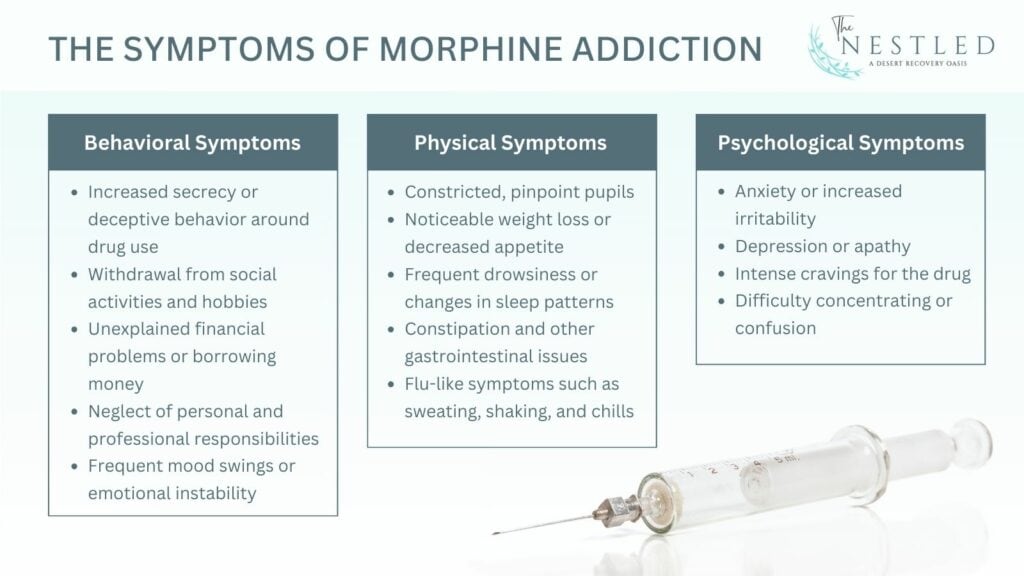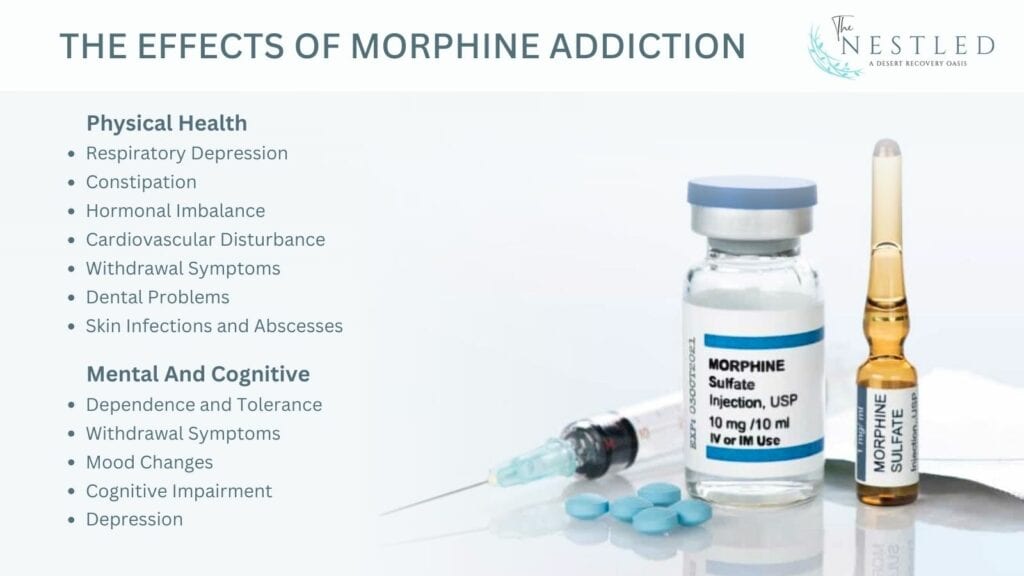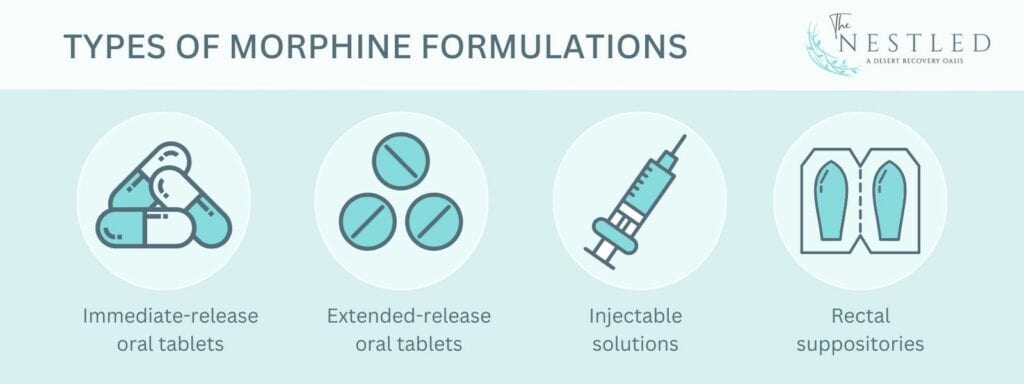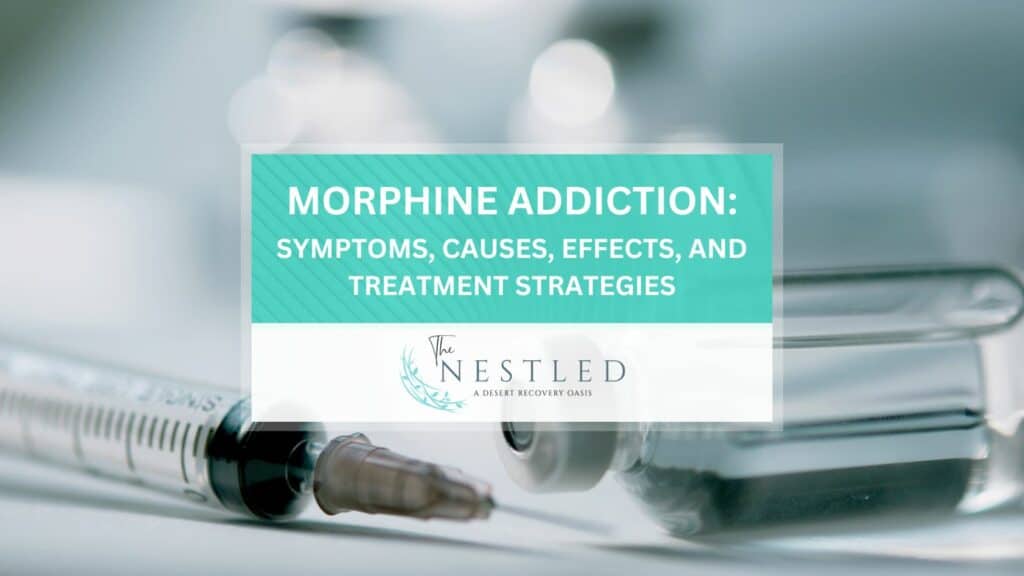Morphine addiction is the uncontrolled use of the drug morphine for its calming effects, disregarding the adverse consequences. Morphine is a powerful pain-relieving medication derived from the opium poppy plant. It belongs to a class of drugs known as opioids, which are used to manage moderate to severe pain.
The symptoms of morphine addiction involve both physical and psychological aspects. Physically, morphine-addicted users might experience weight loss, decreased appetite, and constipation. Psychological symptoms include increased anxiety, depression, and a loss of interest in activities once enjoyed.
Morphine addiction occurs from long-term use or abuse of the drug. Genetic predisposition, environmental factors, high stress or trauma, and social influences like peer pressure also contribute to the development of an addiction.
The effects of morphine addiction include respiratory depression, increased risk of infectious diseases from needle sharing, and overall deterioration of health. Socially, it results in broken relationships, job loss, and financial problems. Psychologically, it causes depression or anxiety, and, in severe cases, it leads to overdose and death.
Treating morphine addiction involves a combination of medical and therapeutic approaches such as detoxification, medication-assisted therapies, counseling, and behavioral therapies.
What Is Morphine Addiction?
Morphine addiction is an intense and compulsive urge to use the drug morphine because of the euphoric effect it produces. Morphine is a pain relief medication, but when abused, it becomes addictive.
According to a 2022 report from the National Survey on Drug Use and Health (NSDUH), more than 5 million people aged 12 and older used morphine products in the past year, with an estimated 375,000 people engaging in nonmedical misuse of morphine or for pleasure.
Morphine addiction is one of the leading painkiller addictions that exist and is abused by millions of people. The drug causes severe dependency that is followed by intense withdrawal symptoms when the individual tries to stop.
The main reason why people fall into morphine addiction is increased tolerance. After a long time using morphine, the body adapts to it and needs a higher dose to achieve the same effect a lower dose gives. The more the individual increases the morphine dosage they take, the harder they fall into addiction.
What Are The Symptoms Of Morphine Addiction?

The American Addiction Centers states that for an individual to be diagnosed with Opioid Use Disorder, OUD (morphine addiction is a type of OUD), an individual must exhibit at least two of the specified criteria over a 12-month period. These criteria include:
Physical Symptoms of morphine addiction:
- Constricted, pinpoint pupils
- Noticeable weight loss or decreased appetite
- Frequent drowsiness or changes in sleep patterns
- Constipation and other gastrointestinal issues
- Flu-like symptoms such as sweating, shaking, and chills (often signs of withdrawal)
Behavioral Symptoms of morphine addiction:
- Increased secrecy or deceptive behavior around drug use
- Withdrawal from social activities and hobbies
- Unexplained financial problems or borrowing money
- Neglect of personal and professional responsibilities
- Frequent mood swings or emotional instability
Psychological Symptoms of morphine addiction:
- Anxiety or increased irritability
- Depression or apathy
- Intense cravings for the drug
- Difficulty concentrating or confusion
These symptoms become more pronounced and noticeable as the addiction deepens. It often leads to more severe health risks and behavioral changes. Recognizing these signs is crucial for seeking timely and effective treatment.
What Are The Causes Of Morphine Addiction?
Morphine addiction is caused by prolonged use, prescription management, genetic factors, psychological factors, and environmental influences. According to the National Center for Drug Abuse Statistics, 9.7 million individuals over 12 of age misuse painkillers, 16.5% for the first time, making it the most abused type of prescription drug.
1. Prolonged Use
Regular or long-term use of morphine, especially in high doses, leads to physical dependence and addiction. Over time, the human body becomes accustomed to the presence of the drug and its effects, making it harder to function normally without it.
This dependency causes an increase in the body’s tolerance to morphine, causing the individual to up the dosage to achieve the desired effect. Increased tolerance is a one-way ticket to addiction.
2. Prescription Mismanagement
Morphine is a pain killer commonly prescribed by healthcare practitioners. Sometimes, healthcare providers do not adequately manage morphine. They might prescribe higher doses than needed or for longer durations than necessary. This misprescription increases the risk of addiction.
When an individual takes morphine for longer than necessary and in higher doses than needed, the body becomes accustomed to the euphoric and calming feeling the drug gives and craves it. This craving is what leads to addiction.
3. Genetic Factors
Individuals with a family history of addiction are at a higher risk of getting addicted to morphine. Genetics influences how susceptible a person is to developing an addiction. It affects how their body processes and reacts to drugs.
People whose genes are susceptible to addiction will quickly crave the compulsive nature of morphine and continually seek out the drug. This inability to resist morphine craving is what leads to its addiction.
4. Psychological Factors
People with mental health disorders such as post-traumatic stress disorder (PTSD), anxiety, and depression tend to use morphine to self-medicate. Self-medicating on morphine leads to dependency because they will always seek relief from their symptoms.
5. Social and Environmental Influences
Environmental factors like stress, peer pressure, and exposure to drug use in one’s social or family circle significantly contribute to the development of addiction. When an individual is exposed to the use of morphine, especially at an early age or from friends, it is easy to try or attempt to use it.
What Are The Effects Of Morphine Addiction?
The effects of morphine addiction seen on a user are health complications, lifestyle changes, psychological impact, and neglect of social relationships.

What Are The Physical Health Effects Of Morphine Addiction?
The physical effects of morphine addiction are respiratory depression, constipation, hormonal imbalance, dental problems, withdrawal symptoms, skin infection, and cardiovascular disturbance.
A 2019 article by Joanna Listos and his collagues from the Department of Pharmacology and Pharmacodynamics, Medical University of Lublin, titled ‘The Mechanisms Involved in Morphine Addiction: An Overview ‘ Morphine and other opioids have a wide range of pharmacological effects.
As this article explains, these drugs can produce strong pain relief, euphoria, and sedation, along with causing endocrine disruption, pupil constriction (miosis), cough suppression, and respiratory depression.
They also trigger muscle spasms and the release of histamine in the peripheral nervous system. Commonly observed in clinical settings, many opioids are primarily used for their analgesic (pain-relieving) properties.
- Respiratory Depression: Morphine slows down one’s breathing. This is one of the most dangerous effects of opioid use, as it can lead to hypoxia (a condition where not enough oxygen reaches the brain), which can cause short-term and long-term neurological damage or even be fatal.
- Constipation: Morphine reduces gastrointestinal motility, leading to severe constipation, which can cause discomfort and other digestive system issues such as bloating and abdominal pain.
- Hormonal Imbalance: Long-term morphine use disrupts the normal functioning of the endocrine system, leading to issues such as reduced libido, infertility, and irregular menstrual cycles in women, and decreased testosterone levels in men, which can lead to reduced sexual drive and performance, and even osteoporosis.
- Cardiovascular Disturbance: Morphine causes lowered blood pressure and heart rate, which is dangerous, particularly for those with pre existing heart conditions.
- Withdrawal Symptoms: People addicted to morphine experience muscle and bone pain, sleep disturbances, diarrhea, vomiting, and cold flashes with goosebumps upon withdrawal.
- Dental Problems: Morphine reduces the production of saliva, leading to dry mouth, which increases the risk of tooth decay and gum disease.
- Skin Infections and Abscesses: Injection drug use also causes local skin infections and abscesses if drugs are injected under unsterile conditions.
What Are The Mental And Cognitive Effects Of Morphine Addiction?
The Mayo Clinic states that extended use of morphine can lead to mental dependence. This is because morphine works by binding to opioid receptors in the brain, specifically those that are part of the system managing pain and reward.
- Dependence and Tolerance: Morphine users become dependent on morphine, meaning they need to take more of the drug to achieve the same effects (tolerance) and experience withdrawal symptoms without it.
- Withdrawal Symptoms: When morphine addicts try to withdraw, they experience withdrawal symptoms like anxiety, depression, irritability, and mood swings. In severe cases, individuals may experience psychosis.
- Mood Changes: Morphine produces feelings of euphoria. Users may swing between feeling euphoric while under the influence to experiencing dysphoria when the effects wear off.
- Cognitive Impairment: Users may find it difficult to concentrate, learn new information, or remember things (impaired memory).
- Depression: The despair and hopelessness that often accompany addiction can deepen pre-existing depression or trigger new depressive episodes.
How Does Morphine Affect The Brain?
Morphine affects the brain by binding to opioid receptors, particularly the mu-opioid receptors, which are located throughout the central nervous system. When morphine binds to these receptors, it activates a cascade of biochemical events that result in reduced perception of pain, feelings of euphoria, and sedation.
Morphine also inhibits the release of neurotransmitters involved in pain signaling, such as the substance P, thereby further reducing the sensation of pain. However, prolonged use of morphine leads to tolerance, dependence, and addiction, as well as potential side effects such as respiratory depression, constipation, and drowsiness.
What Are The Social Consequences Of Morphine Addiction?
Morphine addiction often leads to strained relationships with family and friends because of changes in behavior. People with morphine use disorder tend to isolate themselves and withdraw from social activities. They neglect their responsibilities and exhibit secretive behavior about their drug use.
Morphine addiction also increases the likelihood of the individual losing their job and experiencing financial difficulties—the person’s focus shifts from their responsibilities to obtaining and using the drug.
What Are The Types Of Morphine?

Morphine is primarily available in 4 formulations:
- Immediate-release oral tablets: These provide quick relief of moderate to severe pain and are typically taken every 4 to 6 hours as needed.
- Extended-release oral tablets: These are formulated to provide prolonged pain relief over 12 to 24 hours and are taken less frequently than immediate-release tablets.
- Injectable solutions: These are administered intravenously, intramuscularly, or subcutaneously in medical settings for acute pain management, such as post-surgery or during labor.
- Rectal suppositories: These are used for patients who are unable to take oral medications or require consistent pain relief over an extended period.
How To Treat Morphine Overdose?
Treating a morphine overdose requires immediate medical attention. If someone is experiencing an overdose, call emergency services right away. While waiting for help, monitor the person’s vital signs and try to keep them awake and breathing.
Do not induce vomiting unless instructed by medical professionals. Emergency responders may administer naloxone, a medication that reverses the effects of opioid overdose. If available. Supportive care, such as respiratory support and intravenous fluids, will be available in a medical setting.
It’s crucial to provide information about the amount and time of morphine ingestion for appropriate treatment.
What Are The Treatment Strategies For Morphine Addiction?
The treatment strategies for morphine addiction are detoxification, Medical-Assisted Treatment, counseling, support groups, holistic therapy, and aftercare planning.
1. Detoxification
Detoxification is the first step in treating morphine addiction. It involves safely removing the drug from the body under medical supervision. The detoxification process helps the individual manage withdrawal symptoms, which are often severe and potentially life-threatening.
For effective results, detoxification should be combined with other treatment options like Medication Assisted Treatments and other behavioral therapies The 2019 issue of Harvard Health Publishing, titled “Treating opiate addiction, Part I: Detoxification and maintenance,” states that detoxification alone is insufficient, as most individuals with opioid use disorder tend to relapse without additional intervention and support.
2. Medication-Assisted Treatment (MAT)
MAT involves the use of medicines like methadone, buprenorphine, or naltrexone to reduce morphine cravings and withdrawal symptoms. These medications make it easier to wean off morphine. They act on the same opioid receptors in the brain as morphine but are safer and less likely to produce harmful addictive behaviors.
The National Center on Substance Abuse and Child Welfare states that MAT, when integrated with counseling and various therapeutic methods, offers a comprehensive approach to treating the whole patient.
3. Counseling and Behavioral Therapies
Therapies like cognitive-behavioral therapy (CBT), motivational interviewing, and group therapy help individuals understand the cause of their addiction. Therapy also provides:
- Strategies for coping with cravings.
- Avoiding relapse.
- Managing life stressors without drugs.
4. Support Groups
Support groups are essential for every other day living with addiction. Participating in support groups provides encouragement from others who are facing similar challenges. These groups give a sense of community and share experiences that are vital in recovery.
5. Holistic Therapies
Holistic treatments include yoga, meditation, and acupuncture. They help medical treatments and behavioral therapies by improving the addicted individual’s mental health and overall well-being.
These practices help manage stress, reduce anxiety, and increase the emotional resilience needed to overcome addiction.
6. Aftercare Planning
Long-term success in recovery depends on thorough aftercare planning. Aftercare planning includes ongoing therapy, continued participation in support groups, and sometimes sober living environments. Aftercare helps individuals navigate life after treatment and maintain their sobriety.
These treatment strategies are tailored to the individual’s specific needs and circumstances. They significantly improve the chances of successful recovery from morphine addiction.
How Quickly Can Someone Become Addicted To Morphine?
The speed at which someone becomes addicted to morphine depends on factors such as the dosage, frequency of use, method of administration, and individual susceptibility.
According to Johns Hopkins Medicine, the time required to develop physical dependence on opioids, like morphine, can differ widely among individuals, but it’s typically within a few weeks.
Some people develop signs of addiction within a few weeks, especially if the drug is used frequently or in higher doses than prescribed.
What Are The Risks Of Morphine Addiction while Pregnant?
Morphine addiction during pregnancy increases the probability of having complications like premature birth, low birth weight, and withdrawal symptoms in newborns (neonatal abstinence syndrome). It’s crucial for pregnant women suffering from addiction to seek specialized medical care to manage their addiction and reduce risks to the fetus.
Is It Safe To Detox From Morphine At Home?
Detoxing from morphine at home is risky without professional supervision, especially for those with severe addiction. Withdrawal symptoms are painful and sometimes life-threatening. Medical detox programs provide safe environments to manage withdrawal with medical assistance to reduce discomfort and complications.
Where To Find Treatment For Morphine Addiction?
Treatment for morphine addiction can be found at rehabilitation centers, addiction treatment facilities, or through medical professionals specializing in addiction recovery.
What are the similarities and differences between the withdrawal symptoms of morphine and ketamine addiction?
Withdrawal symptoms for morphine and ketamine addiction share some similarities but also have distinct differences due to their different pharmacological effects. Morphine withdrawal symptoms include severe muscle aches, agitation, insomnia, gastrointestinal distress, and intense cravings. These symptoms can be extremely uncomfortable and require a carefully managed detox process with medications to ease the symptoms. Ketamine withdrawal symptoms, on the other hand, can include agitation, anxiety, cravings, and physical discomfort, but they are generally less severe than those of opioids like morphine.
How does the risk of polydrug use complicate the treatment of morphine addiction?
The risk of polydrug use significantly complicates the treatment of morphine addiction because combining morphine with other substances, such as tobacco, alcohol, or ketamine, can lead to more severe health risks and complex withdrawal symptoms. Polydrug use increases the potential for dangerous interactions, such as enhanced respiratory depression when opioids are combined with other central nervous system depressants like alcohol or benzodiazepines.
What Are The Different Slang Terms For morphine?
Slang terms for morphine include vikes, Norco, and Watson-387.
Where And How Is Morphine Typically Manufactured And Produced?
Morphine is usually manufactured by pharmaceutical companies and is produced in controlled environments.
What Is The Role Of Law Enforcement Agencies In Combating Morphine Distribution And Use?
Law enforcement agencies play a crucial role in enforcing laws related to morphine distribution and use.
What Are The Legal Penalties For Using And Selling Morphine?
The legal consequences for using and selling morphine include fines, imprisonment, and legal records.

Share This Post




